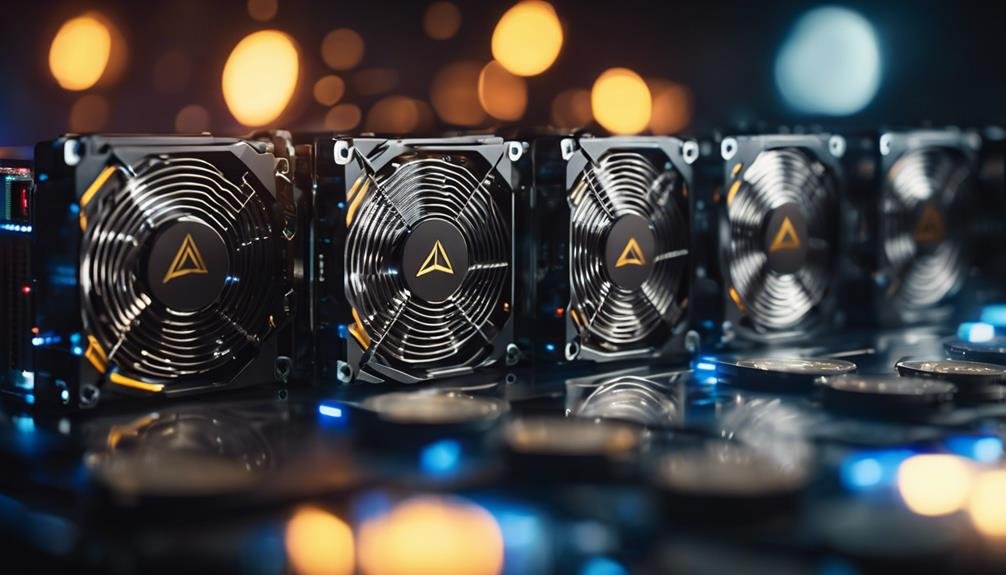Starting to mine Ether offers a chance to be part of Ethereum’s burgeoning financial ecosystem, leveraging its decentralized applications and smart contracts. Ethereum mining involves solving complex puzzles with GPUs, yielding 2 ETH per block approximately every 15 seconds. Ideal setups use AMD graphics cards with at least 6GB RAM and updated drivers. Joining a mining pool can enhance earnings by pooling resources and increasing the chance of frequent rewards. Energy costs, hardware efficiency, and Ethereum’s shift to proof-of-stake influence profitability. Discover key strategies to maximize your earnings and stay ahead in this evolving industry.
Table of Contents
Brief Overview of Beginners Guide To Mining Ether
- Decentralized Applications: Ethereum supports a wide range of DApps and smart contracts, fostering innovation and diverse financial services.
- Transition to PoS: Ethereum’s move to PoS improves scalability and energy efficiency, making it more sustainable for future growth.
- Consistent Rewards: Mining pools increase chances of regular rewards by pooling resources and distributing earnings based on contributed hashing power.
- Profit Potential: Mining profitability depends on factors like network difficulty, electricity costs, and ETH price, with potential for significant returns.
What Is Ethereum?
Ever wondered how Ethereum revolutionizes the digital landscape with its decentralized blockchain platform and smart contracts? Ethereum stands as a trailblazer in the cryptocurrency domain, offering a versatile blockchain that supports decentralized applications (DApps) and smart contracts. Unlike traditional systems that rely on third-party intermediaries, Ethereum’s decentralized architecture guarantees that transactions and applications run seamlessly and securely.
At the core of Ethereum is its native cryptocurrency, Ether (ETH), which fuels the network. Ether isn’t only a medium for transactions but also compensates participants who validate transactions and perform computations. Ethereum initially adopted a proof-of-work (PoW) consensus mechanism, where miners receive mining rewards for solving complex mathematical problems. This system, however, is evolving to proof-of-stake (PoS) to enhance scalability and energy efficiency.
Ethereum’s blockchain processes transactions approximately every 15 seconds, a stark contrast to Bitcoin’s 10-minute average, enabling quicker transaction confirmations. This efficiency has propelled the rise of decentralized finance (DeFi) and numerous financial services, transforming the financial sector.
With Ethereum, you’re engaging in a robust ecosystem that fosters innovation and underpins a myriad of decentralized applications and financial services.
How Ethereum Mining Works
Understanding how Ethereum mining works involves delving into the proof-of-work (PoW) system, where miners solve intricate mathematical puzzles to validate transactions and secure the network, earning rewards in Ether (ETH).
The mining process primarily utilizes graphics processing units (GPUs) due to the Ethash algorithm’s memory-hard design, which makes application-specific integrated circuits (ASICs) less effective.
In this PoW system, each mined block on the Ethereum blockchain takes about 15 seconds to complete. Miners who successfully solve the puzzles are rewarded with 2 ETH coins plus transaction fees.
The hash rate, a measure of computational power, plays a vital role in determining your mining efficiency. A higher hash rate increases your chances of solving a block and earning rewards.
However, mining profitability isn’t constant and depends on several factors. Network difficulty, which adjusts based on the total computational power of the network, can increase, making it harder to mine ETH.
Additionally, the current ETH/USD exchange rate and local electricity costs greatly impact your returns. Understanding these elements is essential for optimizing your mining strategy and ensuring you remain profitable in this competitive landscape.
Ethereum Mining Hardware

When choosing Ethereum mining hardware, you’ll need to focus on GPUs due to their superior performance with the memory-intensive Ethash algorithm. The minimum requirements include a low-end CPU, 4GB of RAM, and a GPU with at least 3GB RAM, though 6GB is recommended for ideal results.
AMD graphics cards are often preferred because they usually offer a higher hash rate and better efficiency compared to Nvidia. However, it’s important to evaluate the hash rate, energy consumption, and purchase price to calculate long-term profitability. Use a profitability calculator to estimate returns based on these variables.
Your mining rig’s Power Supply Unit (PSU) must provide adequate wattage, adding a 10-15% buffer above the total power draw. This guarantees stability and prevents hardware failure.
Additionally, maintaining up-to-date GPU drivers is vital for maximizing performance. The choice between AMD and Nvidia ultimately depends on specific models, as some Nvidia cards can be competitive in certain scenarios.
Mining Software Setup
To kick off your Ethereum mining journey, selecting the right mining software like Claymore, Ethminer, or PhoenixMiner is fundamental for enhancing GPU performance with the Ethash algorithm. Each of these options has its strengths, but all are designed to maximize the hashing power of your processing unit (GPU).
Before diving in, verify your AMD or Nvidia GPUs have the latest drivers installed to boost mining efficiency and stability.
Configuring your mining software requires creating a batch file with specific commands. This file should include your wallet address and, though it’s advisable to join a mining pool, the information pertinent to it. This setup is significant for streamlining the ETH mining process.
Monitoring performance is essential. Regularly check your hashing speed and GPU temperatures to prevent overheating and guarantee top-notch operation. Consistent performance monitoring can help you tweak settings to maximize output and longevity of your hardware.
For hardware requirements, robust GPUs with significant memory are required, as Ethereum’s Ethash algorithm is memory-intensive. Proper configuration and monitoring can substantially boost your rewards and efficiency, making your venture into mining Ethereum both productive and sustainable.
Joining a Mining Pool

After configuring your mining software, joining a mining pool can greatly enhance your chances of earning consistent rewards by combining your computational power with other miners.
By pooling resources, your collective hashing power increases, leading to more frequent block discoveries and a steady stream of smaller, yet consistent, payouts. This is particularly beneficial for smaller miners who may struggle with the long waiting times and high variability of solo mining.
Mining pools distribute rewards based on the amount of hashing power you contribute. For instance, larger pools like FoundryUSA, which control around 30% of Bitcoin’s hash rate, exemplify the scale and profitability of collective efforts. Although Ethereum pools are smaller, the principle remains the same: pooling resources leads to more reliable earnings.
Most mining pools charge a small fee, typically around 1-2% of the rewards. While this fee slightly impacts your overall profitability, the increased likelihood of earning rewards regularly often outweighs the cost.
Consequently, joining a mining pool not only mitigates risk but also enhances your income stability through more frequent payouts. Balancing the fees and the benefits of collective efforts is essential in maximizing your mining profitability.
Calculating Profitability
Understanding the intricate variables affecting Ethereum mining profitability is vital for making informed decisions and enhancing your returns. Mining profitability hinges on several key factors: the block reward, currently set at 2 ETH per mined block, and local electricity costs, ideally kept below $0.12/kWh for peak returns.
Utilizing mining profitability calculators allows you to estimate earnings by inputting your hash rate, power consumption, and the ETH/USD exchange rate, all based on real-time network data.
Transaction fees also play a considerable role, especially during periods of high network activity, where they can remarkably boost daily revenue. The return on investment (ROI) for mining hardware can vary, but successful operations typically aim to recoup their costs within a few months to a year, depending on market conditions.
Historical data indicates that miner income can fluctuate greatly, making continuous monitoring and adjustments to your mining strategies vital. To maintain profitability, you must stay vigilant and adapt to changing network conditions.
Regularly updating your calculations and strategies guarantees that you can respond effectively to shifts in difficulty, ETH prices, and transaction fee dynamics. By considering these variables, you’ll maximize your chances of achieving a profitable Ethereum mining operation.
Energy and Cost Considerations

When considering Ethereum mining, one of the most essential factors is the energy cost, as it directly impacts the profitability of your operations. Energy consumption of your mining rig will greatly influence your overall expenses. Most mining rigs consume between 1,000 to 2,500 watts per hour, making local electricity costs vital. Ideally, you should aim for a rate under $0.12/kWh; anything higher can make your home mining operation unprofitable.
Electricity costs exceeding $0.20/kWh are common in many areas, but professional miners often secure lower rates, highlighting the importance of your location. Utilizing mining calculators is imperative to estimate potential profits, accounting for network difficulty, block rewards, and, importantly, electricity costs. These tools help you make informed decisions about your mining endeavors.
Don’t overlook the fixed costs for essential components like power supply units (PSUs). These contribute to the operational expenses and must be factored into your financial analysis. Understanding these cost elements allows you to gauge the profitability of your mining operation more accurately.
Transition to Proof-of-Stake
As Ethereum changes from a proof-of-work (PoW) system to a proof-of-stake (PoS) consensus mechanism by late 2022, the shift aims to enhance the network’s scalability, security, and energy efficiency, reducing energy consumption by an impressive 99.95%.
This change marks a significant departure from traditional Ethereum mining, where miners rely on computational power to validate transactions. Instead, PoS will require participants to stake ETH in a cryptocurrency wallet, thereby becoming validators.
During this evolving phase, known as Ethereum 2.0, the Ethereum network will undergo multiple phases. Phase 0 introduced the Beacon Chain in December 2020, laying the groundwork for PoS. Subsequent phases will focus on sharding and fully integrating PoS, which will eventually replace PoW altogether.
For existing miners, this means adapting to a new model where rewards are earned through staking ETH rather than mining. This change isn’t just about earning rewards; it’s also about contributing to a more sustainable and scalable network.
Security and Best Practices

To secure your cryptocurrency investments effectively, implement robust password policies and enable two-factor authentication (2FA) on your wallet. These measures greatly enhance security, making unauthorized access to your cryptocurrency wallet more difficult.
Additionally, regularly back up your wallet’s private keys and recovery phrases, storing them securely offline. This step is vital to prevent loss from hardware failures or cyber attacks.
Keep your mining software and hardware drivers updated. Outdated software can harbor vulnerabilities that malicious actors exploit, so timely updates minimize these risks.
Monitoring your mining rig is also essential. Look out for unusual activity or performance drops, as these can indicate security breaches or hardware issues needing immediate attention.
Given the high-energy equipment involved in mining, fire safety is another important consideration. Implement smoke detectors and keep fire extinguishers nearby to mitigate the heightened risk of electrical fires.
These precautions aren’t just about protecting your investment but ensuring overall operational safety.
Frequently Asked Questions
Should I Start Mining Ethereum?
Yes, you should consider mining Ethereum if you analyze factors like Ethereum profitability, mining equipment costs, and energy consumption.
Evaluate your hardware requirements and software options carefully.
Joining mining pools can enhance your returns, while monitoring market trends will help you stay profitable.
The community support can guide you through setup and troubleshooting.
Why Do People Mine Ethereum?
People mine Ethereum for its profit potential and mining rewards.
You’ll help maintain network security and support decentralized finance.
With lower energy consumption compared to Bitcoin, it’s more efficient.
However, be aware of market volatility and hardware requirements.
The Ethereum community offers robust support, but future prospects include a shift to proof-of-stake, which may impact earnings.
Analyze your costs and access to low electricity rates carefully.
How to Mine Ethereum for Beginners?
To mine Ethereum for beginners, start by selecting robust mining hardware and downloading mining software like Claymore.
Join mining pools to stabilize your earnings. Always analyze electricity costs and profitability.
Understanding mining algorithms enhances network security.
Follow a detailed setup guide and monitor your mining performance.
Regularly conduct profitability analysis.
Stay proactive with troubleshooting tips to guarantee your operations remain efficient and profitable amidst changing market conditions.
How to Start Crypto Mining for Beginners?
To start crypto mining, first understand the hardware requirements, such as a powerful GPU.
Choose reliable software options like Claymore.
Join mining pools to boost rewards.
Analyze energy consumption and profitability to guarantee it’s worth the investment.
Learn about mining algorithms and stay updated on legal considerations.
Avoid beginner mistakes like neglecting cooling systems.
A data-driven approach will help you make informed decisions.
Summarizing
In summary, starting to mine Ether requires a solid understanding of Ethereum, the right hardware, and software setup.
Joining a mining pool and calculating profitability are essential steps for maximizing your earnings.
Be mindful of energy costs and stay updated on Ethereum’s shift to proof-of-stake, which will impact mining rewards.
Prioritize security and best practices to safeguard your investments.
By carefully analyzing these factors, you can make informed decisions and effectively navigate the Ethereum mining landscape.




